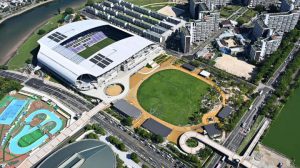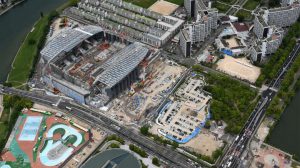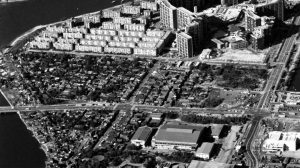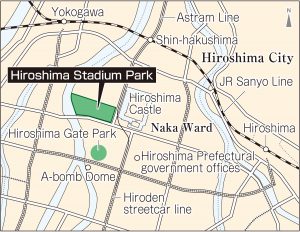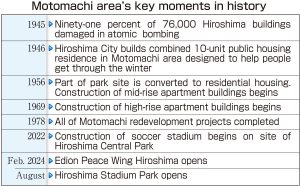Motomachi transformed from residential area to public gathering spot with opening of Hiroshima Stadium Park
Aug. 1, 2024
by Yu Kawakami, Staff Writer
On August 1, Hiroshima Stadium Park is scheduled to open fully, with a plaza space and commercial facilities centered on Edion Peace Wing Hiroshima, the new soccer stadium in Hiroshima’s Naka Ward. The Stadium Park’s Motomachi area serves as a symbol of Hiroshima’s history. At one time land used for military purposes, the area became lined with public housing units in the recovery period after the atomic bombing. After its time serving as Hiroshima Central Park, the area has been transformed into a spot for attracting large crowds.
Motomachi, the area around Hiroshima Castle, quite literally means “the birthplace” of Hiroshima. After Japan’s Meiji era (1868–1912), military units and related facilities were concentrated in the area. When an excavation survey was conducted in 2020 and 2021 in conjunction with the soccer stadium’s construction, A-bombed remnants of the former Imperial Japanese Army’s Chugoku District transport soldier recruitment unit (in Japanese, “Shichotai”) were unearthed there. A part of the excavated stone pavements used in stables for military horses and elsewhere are displayed on the south side of the stadium across the street known as Jonan-dori.
The area around one kilometer from the hypocenter was completely destroyed in the atomic bombing. To deal with a shortage of residential housing after the bombing, the Hiroshima City government constructed public housing for around 1,800 households. Many A-bomb survivors and those repatriated from overseas began to return to reside there, leading to a concentration of unlicensed housing along the Honkawa River. It became a district of shacks and was dubbed the “A-bomb slum.”
In 1969, full-scale construction of high-rise apartment buildings began in the area, a project that was completed over a period of around 10 years. Kazumasa Nakamura, 82, who used to live in a combined 10-unit public housing residence in Motomachi with his family, continues to live in a mid-rise apartment complex in the same area. Mr. Nakamura said, “I think it’s fine that the neighboring area will become a beautiful park, but I don’t want memories of its post-war period to be erased.”
After the housing was eliminated, the huge, roughly 8.4-hectare area became a public space for rest and relaxation. In 2003, around 6,000 people gathered in the area from around Japan, forming words that read “NO WAR NO DU!” (DU: depleted uranium), a message spelled out in opposition to the attack on Iraq in an appeal for peace.
The business group responsible for development and management of the Stadium Park erected low-rise commercial buildings around the green area, under the concepts of “Passing on characteristics unique to leafy Central Park” and “In harmony with the new stadium.” The group has created an environment in which people can enjoy themselves throughout the four seasons, such as by engaging in waterfront barbeques. The park is expected to play the role of attracting not only soccer fans but also tourists to Peace Memorial Park in Hiroshima’s Naka Ward from Japan and other nations, as well as encouraging people to get around the downtown area more.
(Originally published on August 1, 2024)
On August 1, Hiroshima Stadium Park is scheduled to open fully, with a plaza space and commercial facilities centered on Edion Peace Wing Hiroshima, the new soccer stadium in Hiroshima’s Naka Ward. The Stadium Park’s Motomachi area serves as a symbol of Hiroshima’s history. At one time land used for military purposes, the area became lined with public housing units in the recovery period after the atomic bombing. After its time serving as Hiroshima Central Park, the area has been transformed into a spot for attracting large crowds.
Motomachi, the area around Hiroshima Castle, quite literally means “the birthplace” of Hiroshima. After Japan’s Meiji era (1868–1912), military units and related facilities were concentrated in the area. When an excavation survey was conducted in 2020 and 2021 in conjunction with the soccer stadium’s construction, A-bombed remnants of the former Imperial Japanese Army’s Chugoku District transport soldier recruitment unit (in Japanese, “Shichotai”) were unearthed there. A part of the excavated stone pavements used in stables for military horses and elsewhere are displayed on the south side of the stadium across the street known as Jonan-dori.
The area around one kilometer from the hypocenter was completely destroyed in the atomic bombing. To deal with a shortage of residential housing after the bombing, the Hiroshima City government constructed public housing for around 1,800 households. Many A-bomb survivors and those repatriated from overseas began to return to reside there, leading to a concentration of unlicensed housing along the Honkawa River. It became a district of shacks and was dubbed the “A-bomb slum.”
In 1969, full-scale construction of high-rise apartment buildings began in the area, a project that was completed over a period of around 10 years. Kazumasa Nakamura, 82, who used to live in a combined 10-unit public housing residence in Motomachi with his family, continues to live in a mid-rise apartment complex in the same area. Mr. Nakamura said, “I think it’s fine that the neighboring area will become a beautiful park, but I don’t want memories of its post-war period to be erased.”
After the housing was eliminated, the huge, roughly 8.4-hectare area became a public space for rest and relaxation. In 2003, around 6,000 people gathered in the area from around Japan, forming words that read “NO WAR NO DU!” (DU: depleted uranium), a message spelled out in opposition to the attack on Iraq in an appeal for peace.
The business group responsible for development and management of the Stadium Park erected low-rise commercial buildings around the green area, under the concepts of “Passing on characteristics unique to leafy Central Park” and “In harmony with the new stadium.” The group has created an environment in which people can enjoy themselves throughout the four seasons, such as by engaging in waterfront barbeques. The park is expected to play the role of attracting not only soccer fans but also tourists to Peace Memorial Park in Hiroshima’s Naka Ward from Japan and other nations, as well as encouraging people to get around the downtown area more.
(Originally published on August 1, 2024)

